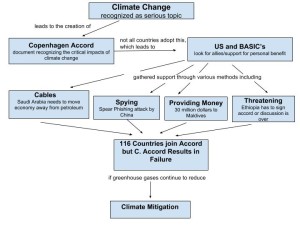Through this diagram I decided to show how the recognition of climate change as a serious issue lead to the drafting of the Copenhagen Accord and eventually lead to realization that new climate mitigation is essential to create a more sustainable environment. Once the Copenhagen Accord was created, all countries did not immediately adopt to the ideas of the Accord and therefore lead to the United States and the BASIC’s to look for allies to support them for their own personal benefit. In order to gain other countries support these countries had to use a variety of tactics and methods. The problem in this, and as I showed in my diagram is that some of the methods used by these countries lead to countries questioning how much trust they can put in other countries. Some questionable tactics used by the U.S and the BASIC’s include cables, spying and threatening. An example shown in this diagram of how cables came in handy is how US was informed that Saudi Arabia needed to move their economy away from petroleum which lead the US to commit to help Saudi Arabia with its “economic diversification efforts would ‘take the pressure off climate change negotiations’.” Other ways of gaining allies was to spy, which was used by China through spear phishing as well as countries providing money to others in order to gain support. The US also at one point used the method of threatening especially in the case of Ethiopia and basically made an ultimatum for Ethiopia forcing them to sign the accord. In the end, 116 countries ended up joining the Copenhagen Accord however overall the accord resulted in failure mostly because of the lack of trust between countries. I ended off my diagram by showing that if greenhouse gases continue to reduce i will be because of climate mitigation, or in other words, new methods of reducing greenhouse gases.
One of the biggest and most important things to take away from this module is what causes climate change. It is common for people to believe that climate change is caused by temperature increases and the increase in radiation from the sun. Unfortunately, these people are misinformed, and need to be aware that the reason for climate change is mostly due to greenhouse gases from human activity and not from sun radiation. Another important idea to take away from this module is understanding that we are trying to “foster collective action among all of humanity” or in other words, have collective action on mitigation. The reason this is so hard to come by is because different areas of the world have different languages causing a language barrier, people are aware to different extents of climate change and people have different values which cause debate in every major issue. To show how values could come in the way of negotiating mitigation, I recall reading a section of this module that outlined the difficulty in reaching agreements between poorer and richer countries. The small and poorer countries would become bothered by the larger and wealthier countries asking them to watch their use of fossil fuels when they don’t use nearly as much fossil fuels as the bigger country. Looking back on so many failed attempts of reducing greenhouse gases, in this particular case it could be beneficial to instead of, for lack of a better word, “calling out” smaller countries in order to reduce their emissions of greenhouse gases, to make it a national requirement to be informed of the damage the excessive use of fossil fuels can be detrimental to the earth especially since we are burning up fossil fuels at a much faster rate than they are regenerating.


Hey Sabrina! My name is Cassandra Oresko and I caught interest in your blog mainly because we had similar and different ideas in regards to our diagram. Thought we both focused on the idea of climate change, you had a broader focus on the Copenhagen Accord. You focused on the various methods the United States used in order to pursue this treaty, while I focused on reasons why climate change occurred, such as human emission of greenhouse gases. Hopefully, nations will eventually come up with a reasonable and fair solution to soon this worldwide climate change. Overall, you created an excellent diagram and used a lot of explicit detail.
If you get the chance, please check out my blog post!
http://geog030.dutton.psu.edu/2016/04/05/cassandra-oresko-climate-change-module-9/
Hey Sabrina, my name is Jason Brown, and your bog caught my attention. liked how you used bold power words to catch the main idea of each box. Your diagram flows well and I can really see the links from beginning to end. I agree with you when you say that people are misinformed about climate change. In order to solve this problem, people need to be educated about it, so hopefully the government steps up and starts to let the public know more. I like your ideas on making national requirements. Hat would be fair for both large and small countries in the long run.
Here’s the link to my blog if you want to check it out:
http://geog030.dutton.psu.edu/2016/04/05/module-9-the-copenhagen-accord-2/
Great Job!